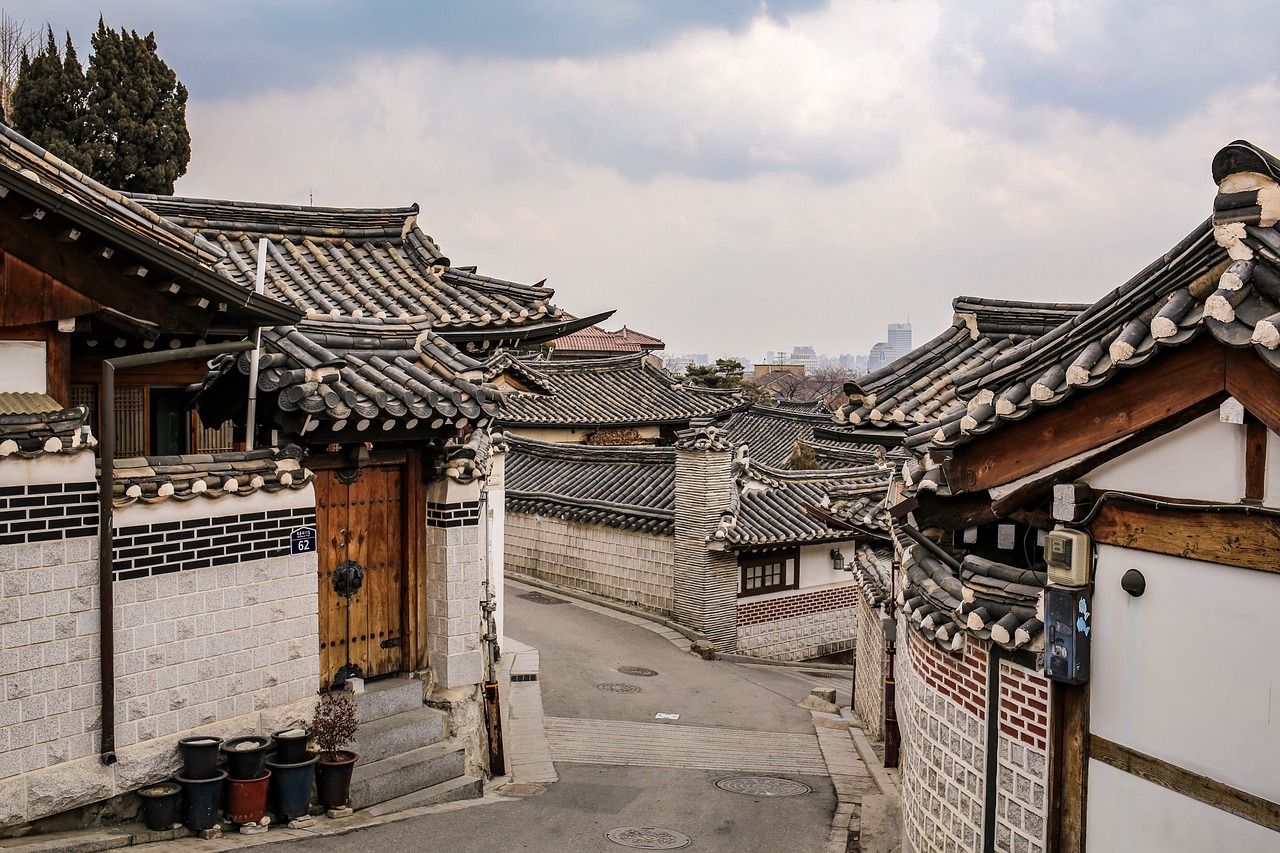Bukchon Hanok Village is an extraordinary fusion of the past and present, nestled within the bustling city of Seoul, South Korea. Emerging 600 years ago as a haven for the affluent and the Joseon dynasty officials, this ancient village stands as an aesthetic charm amongst modernity. With approximately 900 stunning Hanok-styled residences, the neighborhood offers a uniquely authentic and immersive experience of traditional Korean life, being the largest collection of privately-owned Hanok houses in Seoul and South Korea. Engaging activities, stunning panoramas, and rich history await you in this timeless attraction, conveniently accessible via subway, enriching your journey with the richness of traditional Korean culture. The blend of ancient allure and contemporary energy make Bukchon Village a must-see when visiting Seoul, especially during the serene early morning or afternoon hours of spring or autumn seasons.

Definition of Bukchon Hanok Village
Bukchon Hanok Village is an ancient village located amidst the bustling city of Seoul, South Korea. The village is a living piece of history, a testament to the country’s traditional cultural heritage.
Location and surroundings
Nestled between two historically significant attractions, the Gyeongbok Palace and the Changdeok Palace, the village enjoys a prime location. Its unique position in the middle of the city offers a unique, rustic charm that can be experienced amidst the modern urban landscape of Seoul.
Origin and history
Dating back approximately 600 years, Bukchon Hanok Village has a rich historical legacy. It originated as a residential area for officials of the Joseon Dynasty and wealthy nobility. Over time, it evolved into a lively community, preserving the essence of traditional Korean culture and lifestyle.
Current status of the village
Bukchon Hanok Village maintains its historic charm and continues to serve as a vibrant residential community. It houses more than 900 Hanok-style homes, well-preserved and mostly privately owned. It is a destination of great cultural value and a popular tourism site owing to its unique architectural style and opulent history.

Architectural Profile of Bukchon Hanok Village
The village boasts a unique architectural profile, characterised by its Hanok houses.
Description of Hanok architecture
The term ‘Hanok’ refers to traditional Korean houses that exhibit exquisite architectural aesthetics. These houses are designed in harmony with the natural environment, featuring elegant wooden structures, beautifully adorned tiles, and an inner courtyard.
Significance of the 900 preserved Hanoks
Home to over 900 Hanok houses, Bukchon Hanok Village has the largest collection of privately-owned Hanok residences in Seoul. Each Hanok is a living canvas of Korean history, tradition and architectural sophistication.
Modern modifications to traditional Hanoks
To integrate modernity while preserving the traditional essence, the Hanoks in Bukchon Village have been subtly modified. These changes cater to contemporary comforts, yet not compromising the historic authenticity of the structures.
Getting to Bukchon Hanok Village
Ideal method of transportation: Subway
For ease of transportation and accessibility, the subway is the ideal method to reach Bukchon Hanok Village. You can take the line 3 to Anguk Station and exit from gate 2. A 480m walk will lead you to the village entrance.
Other accessible methods for visitors
Apart from subways, other modes of public transportation such as buses and taxis serve the area. You can choose according to your convenience.
Identifying landmarks and signs towards the village
Look for signages pointing towards the village once you’re near the area. It’s best to have a map handy or use a navigation app. Also, known landmarks like the nearby palaces will guide you towards the village if you are within walking vicinity.

Ideal times and seasons for visiting
Morning vs Afternoon visits
For the best experience, consider visiting in the morning or afternoon. These periods ensure you get enough time to wander and explore the village at leisure.
Best months to visit: Spring and Fall
The village exudes a distinct charm in different seasons. Springtime, with blooming flowers and a pleasant climate, and Autumn, with its shifting hues of orange and gold, are apt times for a visit.
How the village changes with the seasons
With the changing of the seasons, the village unveils a new facet of its beauty. From blooming flowers and hanging lanterns in the spring to auburn foliage and traditional festivals in the fall, every season holds its own charm.
Activities within the Village
Hanbok rental details
Embrace the full cultural experience by renting a Hanbok, the traditional Korean dress. There are a number of rental shops around the village where you can hire these for a few hours.
Viewpoint spots within the village for a panoramic view
Make sure to find the numerous viewpoint spots within the village for a panoramic look at the magnificent Hanok rooftops against the backdrop of modern Seoul.
Visiting Baek In-je House – modern-traditional Hanok fusion
A visit to Baek In-je House gives a glimpse into a Hanok with elements of modern architecture.
Exploration of traditional houses, cafes, shops
Wandering around the winding alleys, one can explore the traditional houses, cozy cafes, and boutique shops, each brimming with a unique character.
Craft-making classes: options and schedules
You can also partake in craft-making classes, a hands-on experience of traditional Korean arts. Numerous workshops offer a variety of options, but remember to check schedules in advance.

Entrance Fees and Tickets
Entrance policy for the village
There are no entrance fees to enter Bukchon Hanok Village as it is primarily a residential area. It’s open to locals and tourists alike.
Attractions with entry tickets
Some attractions within the village, like museums or some Hanok homes open for the public, might require an admission fee.
Tips for saving on entry tickets
To save on entry tickets, look for discounts available for seniors, students, or groups. You might also find combined tickets covering multiple sites.
Thoughtful Considerations while Visiting
Appropriate footwear recommendation
Given the steep and uneven traditional streets, wearing comfortable footwear is advisable.
Noise control: respecting residential tranquility
Remember that Bukchon Hanok Village is a residential community. Keep noise levels down to respect the peace and tranquillity of the locals’ homes.
Maintaining the cultural heritage: littering and damage prevention
Help maintain this cultural heritage by refraining from littering and causing damage to the property.
Interesting Facts about Bukchon Hanok Village
Historic events linked to the village
With a history dating back to the Joseon dynasty, the village has been a silent spectator to a myriad of historic events.
Notable former residents
Bukchon Hanok Village was once home to numerous nobles and high-ranking officials of the Joseon dynasty, which marks its historical significance.
Role of the village in South Korea’s cultural preservation
Housing the largest collection of traditional Hanoks, Bukchon Hanok Village plays a key role in preserving South Korea’s cultural heritage.
Nearby Attractions
Gyeongbok and Changdeok Palaces
The royal splendor of Gyeongbok and Changdeok Palaces, located nearby, are a must-visit when you are in the vicinity.
Other significant sites near the village
Several other noteworthy attractions are within a short walk or ride, including the Jongmyo Shrine and the Insadong shopping district.
Where to dine and shop around the village
The area around Bukchon Hanok Village offers a variety of dining options and shopping outlets where you can try local cuisines and buy souvenirs.
Capturing the Experience
Photography guidelines and tips
Bukchon Hanok Village is a treasure trove for photographers. However, remember to respect the local residents’ privacy while capturing pictures.
Ideal spots for the best shots
There are vantage points spread across the village from where you can get panoramic shots of the whole village or the Seoul cityscape.
Sharing your experience: social media etiquette and hash tags
When sharing your experience on social media, be mindful of privacy rules and use appropriate hashtags. Your respectful behavior will encourage others to do the same, preserving this cultural gem for generations to enjoy.

